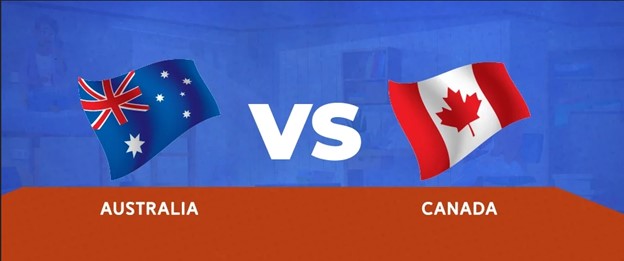Migrating to a new country requires considering various factors to find the best fit for your needs and lifestyle. If you’re deciding between studying or immigrating to Canada vs Australia, both countries offer distinct advantages. Canada is known for its affordable living costs, diverse culture, and high quality of life, while Australia is famous for its top universities, pleasant climate, and outdoor lifestyle.
Both countries have unique cultures and landscapes. Australia offers stunning beaches, diverse wildlife, and a laid-back lifestyle, while Canada boasts vast natural beauty, friendly citizens, and a reputation for inclusivity. If you’re seeking guidance on which destination, Canada or Australia is better suited to your educational and career goals, this comprehensive comparison will help you make the right choice for your future.
Australia vs Canada: General Comparison
In the northern hemisphere, Canada has a population of 38.7 million, making up about 0.5% of the world’s total population. The country spans six time zones, from UTC -2:30 to UTC -7. Its currency, the Canadian dollar (CAD), is relatively strong, with 1 US dollar equivalent to 1.32 CAD. The Canadian passport is ranked the 8th most powerful globally, providing access to 172 countries out of 195.
In contrast, Australia has a population of over 26.3 million, with nearly 30% of residents born overseas. Located in the southeastern hemisphere, Australia covers five time zones between UTC +8 and UTC +10:30. The Australian dollar (AUD) is similarly strong, with 1 US dollar equating to 1.46 AUD. The Australian passport is ranked 7th worldwide, offering visa-free access to 185 countries.Here is a table of comparison between Australia and Canada:
| Category | Australia | Canada |
|---|---|---|
Cost of Living |
Single: AUD 1,655.1/month (USD 1,089.7) | Single: CAD 1,448.1/month (USD 1,054.0) |
| Family of 4: AUD 5,851.2/month (USD 3,852.3) | Family of 4: CAD 5,205.1/month (USD 3,788.6) | |
| Dollar Value | 1 AUD = 0.66 USD | 1 CAD = 0.73 USD |
Cost of Education |
Undergraduate: AUD 20,000–45,000/year | Undergraduate: CAD 29,714/year (USD 22,500) |
| Postgraduate: AUD 22,000–50,000/year | Postgraduate: CAD 17,744/year (US 13,437) | |
| Health Insurance | AUD 450–1,500/year (USD 296–987) | CAD 600–1,200/year (USD 437–874) |
Cost of Housing |
Rent: AUD 1,980–4,636/month (USD 1,304–3,053) | Rent: CAD 1,400–3,000/month (USD 1,040–2,228) |
| Average Home: AUD 1,000,000 (USD 658,000) | Average Home: CAD 696,179 (USD 517,000) | |
| Employment Rate | 64.20% | 61.10% |
| Working Hours for Students | 24 hrs/wk | 20 hrs/wk |
| Working Hours for Non-Students | 7.6 hours per day, amounting to 38 hrs/wk | 8 hours per day, amounting to 40 hrs/wk |
| Australia vs Canada Salary (National Minimum Wage) | AUD 21.38 (USD 13.37) per hour or AUD 812.60 (USD 508.04) per week |
CAD 16.65 (USD 12.31) per hour (federally, as of April 2023) |
Key Differences to Consider When Choosing Between Canada and Australia
When deciding immigration or study between Canada and Australia, here are some important factors.
Weather and Climate in Australia vs Canada
Canada experiences four seasons: harsh winters, warm summers, and moderate spring and fall. Winter temperatures can dip well below freezing, particularly in the north, where it’s common for temperatures to reach -7.7°C (19.9°F) in January. Summer, however, tends to be warm, with average temperatures around 22.5°C (72.5°F) in July.
Australia, in contrast, has a more temperate climate, with mild winters and hot summers. The country enjoys abundant sunshine, promoting an outdoor lifestyle. In southern cities like Melbourne and Sydney, winter temperatures average around 10°C (50°F), while summer can see highs of 30°C (86°F) and beyond. Northern regions, such as Darwin, have a tropical climate, with warm temperatures year-round and distinct wet and dry seasons.
Education in Australia vs Canada

Australia and Canada are home to some of the world’s top universities. If you’re comparing Australia vs Canada for international students, both countries provide exceptional education choices, with cutting-edge research, diverse programs, and a global network.
Here are some of the top universities from each country:
- Canada
- University of Toronto
- Global Rank: 21st
- Strengths:Renowned for research impact and a comprehensive range of programs
- Notable:Over 700 undergraduate and 200 postgraduate degrees
- University of British Columbia (UBC)
- Global Rank: 41st
- Strengths: Strong international community, research excellence in law, medicine, and applied sciences
- Notable:Two main campuses in Vancouver and Okanagan
- University of Toronto
- McGill University
- Global Rank: 49th
- Strengths:Highly regarded medical school, diverse programs
- Notable:Known for producing Rhodes Scholars and Nobel laureates
- Australia
- University of Melbourne
- Global Rank:14th
- Strengths:Excellent academic and employer reputation, research focus, and strong industry connections
- Notable:Vibrant international student community
- University of Melbourne
- University of Sydney
- Global Rank: 19th (Tied)
- Strengths: Extensive research opportunities, strong programs in law, medicine, and the arts
- Notable: Australia’s oldest university
- Australian National University (ANU)
- Global Rank:67th
- Strengths: Research-driven, high academic standards
- Notable:Home to several Nobel laureates among faculty and alumni
Living Cost in Canada vs Australia
When comparing the cost of living in Australia and Canada, various factors, such as housing, groceries, dining, and transportation, must be considered.
Cost of Living Comparison
| Expense Category | Canada | Australia |
|---|---|---|
| Housing | Rent is about 11% lower than in Australia. Utilities and monthly expenses are also lower. | Rent is generally higher. Example: Furnished apartment in Toronto: CAD 3,047 vs. Sydney: AUD 3,820 |
| Groceries | Generally cheaper, with items like milk costing CAD 11.15 per gallon. | Items like milk cost AUD 8.08 per gallon, but some items like eggs and produce can be more expensive. |
| Dining Out | Meal for two at a mid-range restaurant: CAD 100. | Meal for two at a mid-range restaurant: AUD 120. |
| Fast food is also cheaper. | Dining out is generally more expensive. | |
| Transportation | Gas and public transportation are cheaper. Example: Volkswagen Golf costs CAD 34,018. | Gas and public transport are more expensive. The same car costs AUD 40,881. |
| Overall | Generally more affordable, especially in housing, groceries, and transportation. | More expensive, particularly in housing and transportation. |
Student Living Cost Comparison
| Expense Category | Canada | Australia |
|---|---|---|
Accommodation |
On-campus: CAD 4,000 to CAD 16,500/year | On-campus: AUD 800/month |
| Off-campus: CAD 700 to CAD 2,500/month | Off-campus: AUD 700 to AUD 1,500/month | |
| Homestay (with meals): CAD 1,000 to CAD 1,500/month | ||
Food |
Groceries: CAD 300 to CAD 400/month | Average monthly cost: AUD 780 |
| Dining out: CAD 12 to CAD 35 per meal | ||
| Transportation | Public transport: CAD 100 to CAD 150/month | Public transport: AUD 150/month |
Additional Expenses |
Utilities: CAD 92 to CAD 322/month | Utilities and personal expenses vary by location |
| Clothing: CAD 25 to CAD 80/month | ||
| General living expenses: CAD 600 to CAD 800/month | ||
Overall Comparison |
Lower overall cost of living | Generally, a higher cost of living |
| (especially in housing and transportation) |
Canada Economy vs Australia Economy
| Indicator | Canada (US$) | Australia (US$) |
|---|---|---|
| Annual GDP ($M) | $2,173,340 (2023) | $1,775,628 (2023) |
| GDP per Capita | $53,607 (2023) | $67,391 (2023) |
| Debt ($M) | $2,303,042 (2023) | $866,554 (2022) |
| Debt (% of GDP) | 107.50% (2023) | 50.26% (2022) |
| Debt Per Capita | $57,436 (2023) | $32,929 (2022) |
| Deficit ($M) | -$12,270 (2023) | -$37,697 (2022) |
| Deficit (% of GDP) | -0.57% (2023) | -2.19% (2022) |
Career Opportunities in Australia vs Canada
Both Australia and Canada offer a wide range of job opportunities, but there are some differences in their job markets.
Australia has a strong economy focusing on service industries like education, finance, healthcare, and tourism. The country is a popular destination for skilled migrants, with various visa programs to attract workers.
Canada also has a robust economy and a comparatively low unemployment (6.5%), with a diverse job market spanning education, healthcare, manufacturing, natural resources, and technology. There is a high demand for skilled engineering, healthcare, IT, and trades workers.
Quality of Life in Australia vs Canada
Both Canada and Australia are renowned for their high quality of life, offering excellent healthcare, education, and social services. Canada is known for its beautiful landscapes, clean environment, and safety, with cities consistently ranking high in global liveability indexes.
Similarly, Australia provides a world-class healthcare and education system, with a strong emphasis on work-life balance. Its climate, beautiful beaches, and outdoor lifestyle make it an attractive place to live, with cities like Sydney, Melbourne, and Brisbane often ranking among the most liveable in the world.
Immigration Policies of Australia and Canada
Both Canada and Australia have welcoming immigration systems, but there are some differences.
- Canada
- Known for friendly immigration policies.
- Offers programs like Express Entry, Provincial Nominee Program, Canada Visitor Visa, and family sponsorship.
- Designed to attract skilled workers, entrepreneurs, and family members of Canadian residents.
- Sets high immigration targets each year, reflecting openness to new residents.
- Australia
- Uses a points-based immigration system (e.g., General Skilled Visas, State Sponsored Visa).
- Assesses candidates based on factors like age, language proficiency, work experience, and education.
- Offers visa categories for skilled workers, family reunions, and business innovation.
- Immigration policies are slightly stricter than those in Canada, with a more rigorous application process and selection criteria.
Safety of Australia vs Canada
Canada and Australia are recognized for their safety and low crime rates, offering secure environments for residents. While Canada typically ranks slightly higher in global safety indexes, both countries uphold strong rule of law and public safety measures, making them safe places to live and work.
Language and Culture of Australia vs Canada
Canada is bilingual, with English and French as official languages, and is celebrated for its multicultural society, embracing diversity through festivals and events.
Australia, primarily English-speaking, also values cultural diversity shaped by its indigenous heritage and immigrant populations. Both countries are welcoming and inclusive, offering a smooth integration experience for immigrants.
Best Cities for Living and Studying
Australia and Canada provide outstanding cities for international students, offering a range of top-tier options for living and studying.
Canada:
- Toronto: A multicultural city with the University of Toronto, offering strong job prospects in finance, tech, and healthcare.
- Montreal: Affordable living with top universities like McGill, and a thriving job market in tech, healthcare, and education.
- Vancouver: Home to the University of British Columbia, with great job opportunities in tech and engineering and beautiful natural surroundings.
- Ottawa: The capital city, with the University of Ottawa, offering career opportunities in government, tech, and research.
- Quebec City: A French-speaking city with Laval University and a growing job market in AI, healthcare, and software development.
Australia:
- Melbourne: A cultural hub with the University of Melbourne, offering diverse opportunities in education, arts, and tech.
- Sydney: An iconic city with the University of Sydney, boasting a dynamic job market in finance, marketing, and technology.
- Brisbane: Known for its relaxed lifestyle and the University of Queensland, with strong prospects in healthcare, education, and environmental sciences.
- Adelaide: Affordable living with the University of Adelaide and job opportunities in healthcare, education, and manufacturing.
- Perth: Home to the University of Western Australia, offering job prospects in mining, engineering, and tech, along with a vibrant outdoor lifestyle.
Make Your Decision on Canada vs Australia
At this point, you should already know what to choose between Canada vs Australia. Canada stands out for its affordable living, bilingual environment, and welcoming multicultural society. It offers excellent opportunities in healthcare, technology, and research, and its inclusive immigration policies make it an attractive destination for many.
On the other hand, Australia boasts a more temperate climate, a vibrant outdoor lifestyle, and top-ranking universities. The job market, particularly in sectors like healthcare, education, and finance, is thriving, and the country’s diverse population and natural beauty make it an exciting place to live.
Both countries provide a high standard of living and opportunities to grow personally and professionally. Weighing factors such as climate, career goals, education, and cost of living will help you make the best decision for your future.
FAQs About Canada vs Australia
The answer is no. Overall, Canada is generally cheaper to live in than Australia. Housing costs, including rent, are typically lower in Canada, with rent prices about 11% cheaper on average. Groceries are also more affordable in Canada, although some items like eggs and fresh produce may cost more.
Dining out tends to be more expensive in Australia, with meals at mid-range restaurants and fast food costing more. Gas and public transit are cheaper in Canada, with car prices significantly lower. While the cost of living varies by individual preferences and location, Canada offers a more affordable lifestyle.
Choosing between Canada and Australia depends on what you’re looking for. Canada is perfect for those seeking an inclusive immigration policy and a multicultural environment, while Australia is a better fit for those who enjoy a warmer climate and an outdoor lifestyle. Talking to immigration experts or people who have already immigrated can offer helpful insights to guide your decision.
Choosing between Canada and Australia depends on what you’re looking for. Canada is perfect for those seeking an inclusive immigration policy and a multicultural environment, while Australia is a better fit for those who enjoy a warmer climate and an outdoor lifestyle. Talking to immigration experts or people who have already immigrated can offer helpful insights to guide your decision.
No, Canada’s economy is currently lagging behind Australia’s. While both countries are resource-rich and have educated populations, Australia consistently outperforms Canada economically. Australia has lower unemployment (3.9% vs. 6.6%), higher GDP per capita (USD 67,391 vs. USD 53,607), and lower government debt relative to GDP. Australia’s productivity and GDP growth are stronger, and its healthcare system is more efficient, with better access to hospital beds and physicians.
Yes, Australia generally offers higher wages, particularly for certain professional roles. The national minimum wage in Australia is AUD 21.38 (USD 13.37) per hour, while in Canada, the minimum wage varies by province but is CAD 16.65 per hour federally as of 2023. On average, Canadian salaries are around CAD 70,000 per year (CAD 35.90 per hour), while Australian salaries are slightly higher in some sectors.
Yes, Canada is bigger than Australia. In fact, when considering how big is Canada compared to Australia, Canada has an area of about 9,984,670 square kilometres, making it approximately 29% larger than Australia, which only spans 7,741,220 square kilometres.
It’s worth moving to Australia from Canada. Due to the prosperous job market, robust healthcare system, and welcoming policies for expats and international students, Australia is still a wise choice for immigration and study abroad. Though the cost of living in Australia is generally higher than in Canada, the quality of life is better as well.
The Australian passport has a slight stronger functions than the Canadian’s currently. However, both of the two country’s passports offer visa-free or visa-on-arrival access to plenty of countries. With the Australian passport you can access to 186 destinations, yet with Canadian passport, 185 destinations can be accessed.








